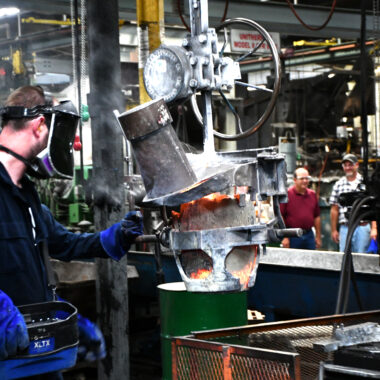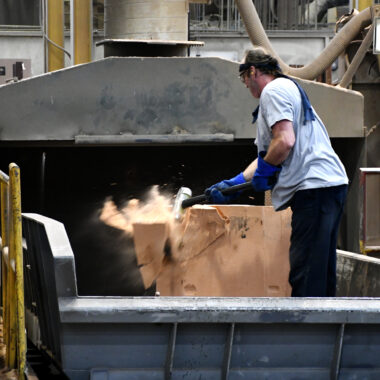Opening the Prospective of Aluminum Spreading: A Comprehensive Review
Aluminum casting stands as a cornerstone in the world of metalworking, providing a wide variety of advantages and applications throughout various industries. As we browse with the landscape of aluminum spreading processes and dig into the intricacies of top quality control procedures, a comprehensive review of opening the true capacity of this steel arises.

Background of Aluminum Spreading
Light weight aluminum spreading has an abundant historic history that dates back to ancient worlds, showcasing the withstanding significance of this metallurgical process in different industries. The roots of aluminum casting can be mapped to around 5,000 B.C. when old human beings like the Egyptians and the Sumerians used fundamental approaches to cast tiny objects. It was not till the 19th century that light weight aluminum spreading saw substantial advancements with the discovery of the Hall-Héroult process for drawing out aluminum from its ore, making it much more available for casting objectives.
The flexibility of aluminum spreading permitted for complicated forms and elaborate layouts to be produced with accuracy, additionally fueling its adoption throughout various markets. Today, aluminum casting proceeds to be a keystone in the manufacturing of a wide array of items, highlighting its long-lasting heritage and value in modern-day manufacturing processes.
Advantages and Applications
With its outstanding strength-to-weight ratio and exceptional thermal conductivity, light weight aluminum spreading uses a myriad of advantages and diverse applications across various industries. One of the primary benefits of aluminum casting is its lightweight nature, making it a suitable choice for markets where weight decrease is essential, such as automobile and aerospace. casting aluminum. In addition, aluminum casting gives exceptional corrosion resistance, making certain resilience and durability in severe environments. Its high thermal conductivity additionally makes it a preferred selection for applications needing warmth dissipation, like in digital parts and warmth exchangers.
In terms of applications, aluminum casting is widely made use of in the vehicle market for elements like engine blocks, cyndrical tube heads, and wheels due to its toughness and light-weight properties. The adaptability of aluminum spreading prolongs to consumer electronics, where it is made use of in the production of casings and warmth sinks.
Kinds Of Light Weight Aluminum Spreading Processes

Amongst the various methods employed in industrial setups, aluminum casting procedures incorporate a range of methods suited to different applications and demands. Financial investment spreading, also recognized as lost-wax casting, is favored for its capacity to create complex and detailed components with a smooth surface finish. Each of these light weight aluminum casting procedures uses distinct advantages, catering to a broad variety of industrial requirements.
Advancements in Light Weight Aluminum Casting Strategies
Recent improvements in light weight aluminum spreading strategies have actually changed the manufacturing industry, offering boosted effectiveness and accuracy in the production of complicated parts. One significant technology is the development of 3D sand printing technology, which makes it possible for the development of elaborate sand molds with minimal manual labor. This method allows for higher layout flexibility and faster production cycles, making it ideal for prototyping and little batch manufacturing.
Moreover, the use of advanced simulation software has actually significantly improved the spreading procedure by enabling designers to optimize mold designs and forecast prospective defects prior to production Look At This starts (casting aluminum). This results in improved item high quality and reduced product waste
In addition, the fostering of vacuum-assisted aluminum casting has actually boosted the overall top quality of castings by reducing porosity and guaranteeing an extra consistent distribution of molten metal. This strategy is specifically useful for elements that need high architectural stability and remarkable surface area coating.
High Quality Control in Light Weight Aluminum Spreading
The advancements in aluminum spreading strategies have not only improved performance and precision yet have actually additionally underscored the crucial value of top quality control in guaranteeing the why not look here dependability and performance of actors parts. Quality assurance in light weight aluminum spreading involves a systematic technique to check and review the production process, recognizing any kind of discrepancies from established criteria that could affect the end product.
One vital aspect of quality assurance is using advanced innovations such as non-destructive testing techniques like X-ray and ultrasound to find internal problems without compromising the stability of the actors parts. Additionally, applying extensive examination protocols at numerous stages of manufacturing assists in recognizing and remedying concerns quickly, making sure that just components satisfying the specified criteria are released for usage.
Moreover, quality assurance extends beyond the production process to encompass post-casting treatments like warmth therapy and surface area completing, assuring that the final items satisfy the preferred specifications. By prioritizing quality control actions, suppliers can enhance product uniformity, durability, and overall customer satisfaction in the realm of aluminum casting.
Final Thought
Various kinds of casting processes and cutting-edge methods have actually been created to enhance the performance and quality of aluminum casting. In general, light weight aluminum spreading continues to be a useful production process with excellent prospective for more developments in visit this website the future.
As we browse with the landscape of light weight aluminum casting procedures and delve right into the intricacies of high quality control steps, a thorough summary of opening the true capacity of this steel arises. It was not till the 19th century that aluminum casting saw considerable improvements with the discovery of the Hall-Héroult procedure for drawing out light weight aluminum from its ore, making it extra accessible for casting objectives.
Amongst the different techniques utilized in industrial settings, aluminum casting processes incorporate a variety of methods fit to various applications and requirements. Financial investment spreading, likewise recognized as lost-wax spreading, is favored for its ability to generate complex and in-depth components with a smooth surface coating. Different types of casting processes and cutting-edge methods have been established to enhance the effectiveness and quality of aluminum casting.